
The Bottom Line
Introduction and Quick Specs
Before we get started, we want to make our readers aware that we've updated our test suite to include low queue depth testing. This involved a great deal of retesting of all of our enterprise SSDs. We felt this is necessary to properly evaluate the DC P3520 because it is a lower queue depth focused SSD. Going forward, we will be including low queue depth random testing (QD1-4) as part of our regular test suite. All of the retesting we had to do has delayed our review of the DC P3520 significantly, so we want to apologize for the delay.
We've been waiting for Intel to deliver 3D flash-based SSDs, and now we have the Intel's first 3D flash-based SSD for the datacenter, the DC P3520. Intel introduces their first-generation 3D MLC flash into the mix with the DC P3520. Intel's new DC P3520 Series NVMe SSDs employ the NVMe software stack over a PCIe Gen3 x4 interface to bring nonvolatile memory as close as possible to the computer's processor. NVMe is architected from the ground-up to remove legacy layers of hard drive interfaces, taking full advantage of the speed and parallelism of solid state nonvolatile memory. NVMe lowers overall CPU overhead because NVMe has a simplified command set which minimizes the number of CPU clocks per I/O which increases QoS in comparison to AHCI. NVMe is designed to be future proof, with a protocol built for current and future non-volatile storage solutions. Previous AHCI interfaces supported only one SQ/CQ (Submission Queue/Command Queue), NVMe supports up to 64K separate SQ/CQ's.
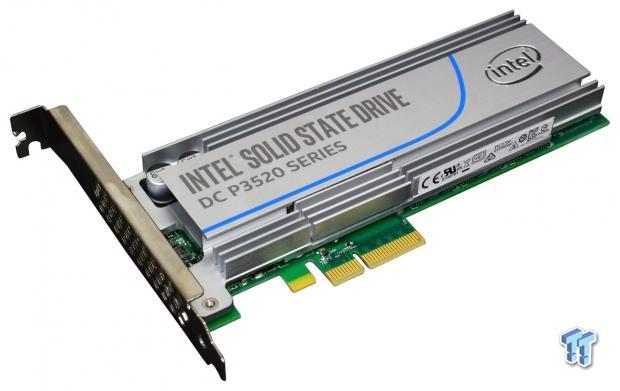
Intel's DC P3520 Series SSDs leverage the same 18-channel controller that we've seen on previous DC P3xxx series and 750 Series SSDs. This controller can deliver exceptional performance, but it is capacity limited to 2GB of DRAM cache for caching data tables and wear leveling data, which in turn limits the SSD capacity to 2TB for a single controller. The DC P3608 utilizes two of these controllers which is why it has a 4TB maximum capacity point. We would like to see larger than 2TB capacity points offered, but with the DC P3520 being a single controller design, 2TB is the max.
The very first NVMe SSD to hit the market was Intel's DC P3700. With the DC P3700, Intel aimed to deliver the very best in performance and endurance. The DC P3700 delivered on both fronts, and even now it is still one of the most powerful options on the market. High-endurance mixed use SSDs offer tons of performance, but at the same time they are very expensive and power hungry beasts.
Intel's first 3D flash-based SSD follows a different path that brings PCIe performance to the mainstream. This path puts high queue-depth performance and class-leading performance on the back-burner and instead focuses on affordability, lower power consumption, and low queue-depth performance for mainstream read-centric applications. We like this strategy because mainstream applications like cloud services are a rapidly growing segment of the datacenter that is best served by mainstream performing PCIe SSDs that are power efficient, read-centric, and deliver good sequential and low queue random performance.
The DC P3520 is essentially a DC P3500 with a 3D flash array. In terms of sequential performance, the DC P3520 takes a back seat to the P3500. The DC P3500 delivers sequential read/write performance of up to 2,800/1,800 MB/s and random 4K read/write performance of up to 430K/28K IOPS at 25 watts of active power consumption. The DC P3520, although not as fast, is much more power efficient delivering sequential read/write performance of 1,700/1,350 MB/s and random 4K read/write performance of up to 357K/26K IOPS at 12 watts of active power consumption.
3D flash allows for higher density at a lower cost, lower power consumption, and increased endurance over conventional planar flash. We mention endurance specifically as it relates to the planar flash based DC P3500. As we stated earlier, the DC P3520 is basically a DC P3500 with a 3D flash array instead of a planar (2D) flash array. Due to its 3D flash array, the DC P3520's endurance rating is 2.5X that of the planar-based DC P3500, which is a testament to one of the many advantages that 3D flash inherently offers over planar flash.
In choosing our test pool, we wanted to include SATA SSDs to demonstrate the advantage that PCIe SSDs bring to the table. We also wanted to show that at low queue depths the DC P3520 performs just as well as more powerful SSDs like the DC P3700.
Quick Specs
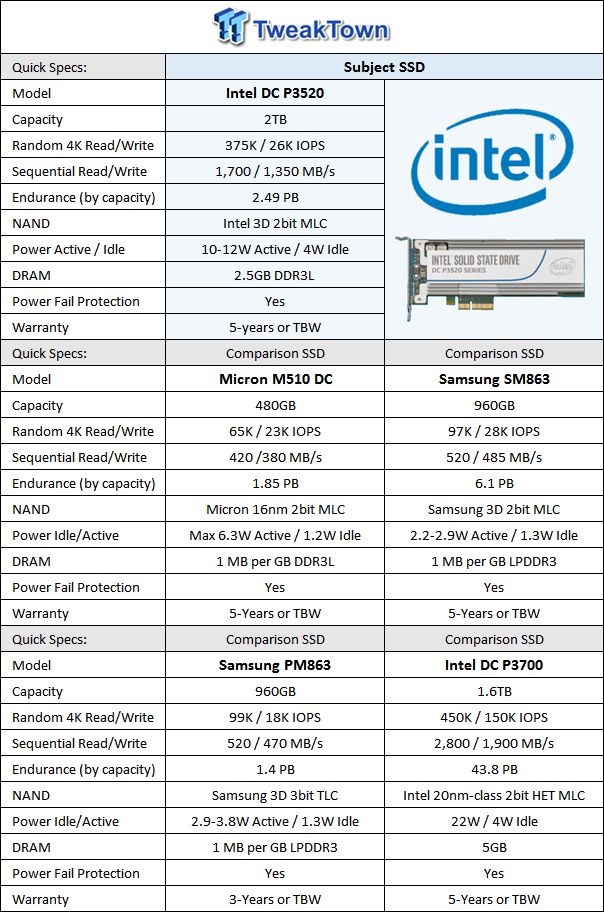
The Intel DC P3520 2TB HHHL AIC we have on the bench today sports the following hardware and steady-state performance specifications: 4K Random Read / Write = 375K/26K. Sequential Read/Write = 1,700/1,350 MB/s. Power consumption = 10-12W Active/4W idle. Controller = Intel 18-channel NVMe controller. NAND = Intel 3D 2bit MLC. Data DRAM Cache = 2GB. Onboard Power-loss Protection = Yes.
Intel warranties the DC P3520 for five years or 2.49 Petabytes Written.
Intel DC P3520 2TB PCIe NVMe SSD-Photos and Specs
Photos
Due to the potential damage that could be caused by removing the DC P3520's heat sink, we will not be doing so. We do know what is under the heat sink, so we will tell you. There are an additional 18 flash packages and three 512MB DRAM packages (one is dedicated for ECC) and of course the 18-channel Intel controller.

The drive ships in basic cardboard packaging.
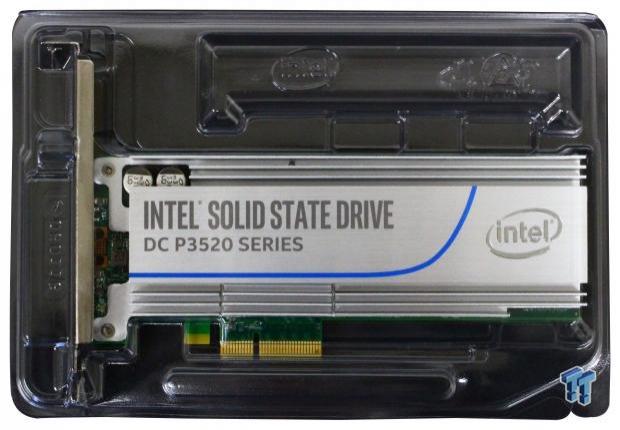
Inside the cardboard packaging, the SSD is protected from shipping damage by a heavy-duty plastic clamshell container. A half-height bracket is included but not pictured.

The controller side of the PCB is covered by a full-length aluminum heat sink. Looking at the top left, we can see two large capacitors that provide host power-loss protection for data in flight.

The bottom half of the PCB has no shielding; the components are exposed. This half of the PCB houses 18 of the drive's 36 Intel 3D flash packages and two of the drive's five 512MB Micron DRAM cache packages. Four DRAM packages are dedicated for block placement and wear leveling data. The fifth DRAM package is dedicated for ECC further guaranteeing data integrity.

A view from the edge connector side of the drive.
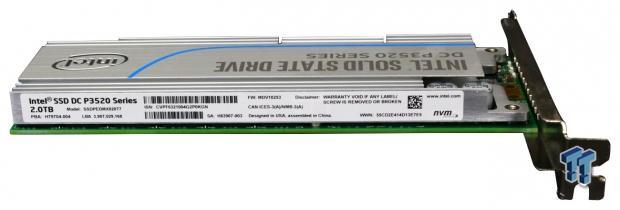
There is a manufacturer label located on the top edge of the heat sink.
Specifications and Features

We are going to go over the 2TB DC P3520's specifications, for other capacities please refer to the above mfg. spec sheet. Intel's DC P3520 2TB Enterprise PCIe NVMe SSD comes in a half-height, half-length, low-profile Add-in Card (AIC) form factor as well as a 2.5" U.2 (SFF-8639) variant. Factory performance specifications for both form factors are identical. The 2TB AIC requires 300 LFM airflow towards the IO bracket. The 2.5" model requires 650 LFM airflow towards the connector.
Features include a PCIe Gen 3.0 x4 interface, Intel 18-channel NVMe controller, and IMFT 3D NAND flash memory. End-to-End data protection featuring XOR parity and advanced LDPC bit correction on all internal and external memories in the data path for protection at every layer.
Intel DC P3520 2TB PCIe NVMe SSD steady-state factory specs:
- Sequential 128KB Read (up to): 1,700 MB/s
- Sequential 128KB Write (up to): 1,350 MB/s
- Random 4KB Read (up to): 375,000 IOPS
- Random 4KB Write (up to): 26,000 IOPS
- Random 4K 7030 Read/Write (up to): 85,000 IOPS
- Random 8K 7030 Read/Write (up to): 45,000 IOPS
- Random Read/Write latency: 130/30us at QD1 (typical)
- Sequential Read/Write latency: 20/20us at QD1 (typical)
Reliability: MTBF 2 million device hours, UBER: <1 sector per 10^17 bits read, T-10 DIF protection, End-to-end data protection, XOR, Temperature Protection, Enhanced power-loss data protection, SMART monitoring, Bad block management, Wear-leveling.
Endurance: PBW (Petabytes Written): 2TB = 2.49 PBW
Security: AES 256-bit Encryption
Pricing: Intel's DC P3520 retails for approximately 50 cents per gigabyte.
Test System Setup and Testing Methodology
Jon's Enterprise SSD Review Test System Specifications
- Motherboard: ASRock Rack EPC612D8A-TB (Intel C612 chipset) - Buy from Amazon
- CPU: Intel Xeon E5-2699 V3 18 Core 36 Thread - Buy from Amazon
- Cooler: Supermicro Air Cooling
- Memory: 64GB Samsung DDR4 ECC 2133MHz - Buy from Amazon
- Video Card: Onboard Video
- Power Supply: Seasonic Platinum 1000 Watt - Buy from Amazon
- OS: Microsoft Windows Server 2012 R2 64 Bit - Buy from Amazon
- Drivers: Intel Proprietary NVMe driver
We would like to thank ASRock Rack, Crucial, Intel, Samsung, Seagate, and Seasonic for making our test system possible.
TweakTown's Enterprise SSD testing methodology replicates typical enterprise workload environments as closely as possible. Our test systems employ enterprise based hardware. Enterprise chipsets, Intel Xeon processors, ECC DRAM, and standard air-cooling. Storage drivers are Windows standard drivers, except as otherwise required for the test device to operate as designed.
TweakTown strictly adheres to industry-accepted Enterprise Solid State Storage testing procedures. Each test we perform repeats the same sequence of the following four steps:
- Secure Erase SSD
- Write entire capacity of SSD a minimum of 2x with 128KB sequential write data, seamlessly transition to next step
- Precondition SSD at maximum QD measured (QD32 for SATA, QD256 for PCIe) with the test specific workload for a sufficient amount of time to reach a constant steady-state, seamlessly transition to next step
- Run test specific workload for 5-minutes at each measured Queue Depth, record results
We chart workload preconditioning IOPS or MB/s and latency for each specific test. We plot workload preconditioning using scatter charts with each recorded 1-second data point represented on the chart, allowing us to see some of the performance variability exhibited by our test subjects. We chart workloads using line charts plotting average workload IOPS or MB/s and latency at each measured QD. Utilizing line charts provides a good visual perspective of the test subject's performance curve.
To summarize, we test with Enterprise hardware, Windows Server Operating System, and we strictly adhere to industry-accepted Enterprise SSD testing procedures. Our goal is to provide results that are consistent, reliable, and repeatable.
Benchmarks - 4K Random Write/Read
4K Random Write/Read

We precondition the drive for 16,000 seconds, or 4.44 hours, receiving performance data every second. We plot this data to observe the test subject's descent into steady-state. We plot both IOPS and Latency. We plot IOPS (represented by blue scatter) in thousands and Latency (represented by orange scatter) in milliseconds. We observe steady-state is achieved at 9,000 seconds of preconditioning. Average steady-state write performance at QD256 is approximately 30K IOPS.


With our configuration, we are able to exceed Intel's 4K random write factory specification of 26,000 IOPS at QD1-256. These charts clearly demonstrate the reason we retested everything at low queue depths. QD1 is arguably the most important random performance metric, and this is where the DC P3520 shines brightest.
At QD1, the DC P3520 has a clear advantage over the DC P3700. The DC P3520 doesn't scale much with increased queue depths; it maxes out at QD4 which is only a little over 2,000 IOPS higher than QD1. The DC P3520 is only a little faster than the best SATA currently has to offer when writing random data. The DC P3520 is definitely read-centric as these charts clearly show.


Again, the DC P3520 has the powerful and expensive DC P3700 beat at QD1 by a significant margin. In fact, the read-centric DC P3520 outperforms the DC P3700 up to QD4 and trails it closely up to QD32. These charts clearly show the massive advantage the DC P3520 has over SATA-based SSDs when reading random data at queue depths above QD4. Even though reading random data usually occurs at lower queue depths, reading data at queues above four occurs at a high enough percentage of the time that the DC P3520 has a clear advantage over SATA-based SSDs. The real differentiator between the DC P3520 and SATA SSDs is its exceptional QoS (Quality of Service) as shown by Intel's spec sheet on page two of this review.
Conclusion (TL;DR): The DC P3520 delivers excellent QD1 write performance that outpaces the more powerful DCP3700. When reading random data, the DC P3520 outperforms the DC P3700 where it matters most QD1-4. The DC P3520's random read performance at queues above four clearly shows the inherent advantage it has over SATA SSDs.
Benchmarks - 8K Random Write/Read
8K Random Write/Read

We precondition the drive for 16,000 seconds, or 4.44 hours, receiving performance data every second. We plot this data to observe the test subject's descent into steady-state. We plot both IOPS and Latency. We plot IOPS (represented by blue scatter) in thousands and Latency (represented by orange scatter) in milliseconds. We observe steady-state is achieved at 7,000 seconds of preconditioning. Average steady-state write performance at QD256 is approximately 15K IOPS.


8K random is a more demanding workload than 4K. This time the DC P3700 has the advantage at QD1. The DC P3520 is performing above factory spec (14K) across the board. The DC P3520 outperforms the SATA-based SSDs in our test pool, either slightly, or by a significant margin. Most importantly it outperforms current SATA-based SSDs at QD1 and does so at a similar price-point.


Just as we saw with our 4K testing, the DC P3520 outperforms the DC P3700 at queue depths of 1-4. With 8K random read data, the DC P3520 displays a huge advantage over SATA-based SSDs at queues above QD16. At QD128, the DC P3520 is delivering 3.5x the performance of the most powerful SATA SSDs. Read-centric workloads at higher queue depths is where the DC P3520 really hits its stride.
Conclusion (TL;DR): The DC P3520 delivers exceptionally strong performance when reading random 8K data at queue depths of 16 and above, where it clearly separates itself from SATA-based SSDs. Additionally, the DC P3520 outperforms the DC P3700 at QD1-4 when reading 8K random data.
Benchmarks - 128K Sequential Write/Read
128K Sequential Write/Read

We precondition the drive for 6,500 seconds, or 1.8 hours, receiving performance data every second. A sequential steady-state is achievable in a much shorter span of time than a random steady-state. We plot both MB/s and Latency. We plot MB/s using blue scatter and Latency using orange scatter. We observe that steady-state is settles in at 1,000 seconds of preconditioning.
The DC P3520 is performing above its factory sequential steady-state write specification of 1,350 MB/s. Average steady-state write performance at QD256 is approximately 1,420 MB/s.


Sequential performance is important, and this is where we see a definitive advantage over SATA-based SSDs. The DC P3520 turns in its best average performance at QD1. None of the other SSDs in our test pool perform best at QD1. At QD1, the mainstream DC P3520 is outperforming the high endurance, high-performance DC P3700. We observe a performance drop of roughly 50 MB/s at QD4.


The DC P3520 comes on strong at QD8, delivering over twice the performance of the SATA SSDs in our test pool. At QD16 and higher, the DC P3520 is cranking out more than three times the sequential read performance of a typical SATA SSD. The DC P3700 has a 700 MB/s advantage over the DC P3520 at higher queues; however, the DC P3520 is a much more power efficient SSD.
Conclusion (TL;DR): The DC P3520 can deliver approximately 3.5X the sequential read performance of SATA SSDs, making it ideal for read-centric applications that benefit from more than the best SATA has to offer.
Mixed Workload Benchmarks - Email Server
Email Server

We precondition the drive for 16,000 seconds, or 4.44 hours, receiving performance data every second. We plot this data to observe the test subject's descent into steady-state. We plot both IOPS and Latency. We plot IOPS (represented by blue scatter) in thousands and Latency (represented by orange scatter) in milliseconds. We observe steady-state is achieved at 7,000 seconds of preconditioning. Average steady-state workload performance at QD256 is approximately 29.5K IOPS.


An Email Server workload is a demanding 8K test with a 50 percent R/W distribution. This application gives a good indication of how well a drive will perform in a write heavy workload environment.
The DC P3520 is intended for read-centric applications as evidenced by this write heavy workload. The DC P3520 does still outperform the best SATA has to offer; however, it's not by a whole lot. Again, we note that the DC P3520 is delivering the best performance of the bunch at QD1. The DC P3520, like the SATA SSDs in our test pool, delivers peak performance at QD16. When we compare the DC P3520 to a lower performing SATA SSD like the M510DC, we find the DC P3520 delivering over 2.5x the performance.
Conclusion (TL;DR): Even though the DC P3520 is a read-centric SSD, it is still able to outperform the best SATA has to offer when subjected to write intensive workloads.
Mixed Workload Benchmarks – OLTP/Database
OLTP/Database

We precondition the drive for 16,000 seconds, or 4.44 hours, receiving performance data every second. We plot this data to observe the test subject's descent into steady-state. We plot both IOPS and Latency. We plot IOPS (represented by blue scatter) in thousands and Latency (represented by orange scatter) in milliseconds. We observe steady-state is achieved at 8,000 seconds of preconditioning. Average steady-state workload performance at QD256 is approximately 41K IOPS. We observe a tight consistent pattern from the DC P3520 after reaching a steady-state.


An On-Line Transaction Processing (OLTP) / Database workload is a demanding 8K test with a 66/33 percent R/W distribution. OLPT is online processing of financial transactions such as credit cards and high-frequency trading in the financial sector. Database workloads are challenging for any storage solution.
Intel specs the 2TB DC P3520 at 45K for a 70/30 workload at QD128. We don't test at 70/30, but rather at 66/33 for our database mix. This is a harder mix for the DC P3520 to digest than a 70/30 mix because of the read-centric nature of the drive. With our database mix, we are getting 42K IOPS at QD32. Based on this result, we believe we would come in right at 45K with a 70/30 mix. Again, at QD1, the DC P3520 is outperforming all of the drives in our test pool including the DC P3700.
Conclusion (TL;DR): The DC P3520 continues to impress at QD1, where it matters most.
Mixed Workload Benchmarks – Web Server
Web Server

We precondition the drive for 16,000 seconds, or 4.44 hours, receiving performance data every second. We plot this data to observe the test subject's descent into steady-state. We plot both IOPS and Latency. We plot IOPS (represented by blue scatter) in thousands and Latency (represented by orange scatter) in milliseconds. We observe steady-state is achieved at 7,000 seconds of preconditioning. We precondition with an inverted (all-write) workload.


The Web Server workload is a pure random read test with a wide range of file sizes. Our test consists of the following file sizes and corresponding percentage of the overall 100 percent workload file size: 512B = 22 percent, 1KB = 15 percent, 2KB = 8 percent, 4KB = 23 percent, 8KB = 15 percent, 16KB = 2 percent, 32KB = 6 percent, 64KB = 7 percent, 128KB = 1 percent, and 512KB = 1 percent.
Although our Web mix does not represent a completely accurate modern web server workload, it is a very taxing workload that does give us a realistic representation of how well an SSD handles an all-read mix. This kind of workload is exactly what the read-centric DC P3520 was designed to do. The DC P3520 is delivering performance that is roughly equivalent to three SATA SSDs at QD64. The DC P3700 has about a 28K advantage at QD256, but it costs more than double what the DC P3520 costs.
Conclusion (TL;DR): The DC P3520 was designed to flourish in a read-centric environment, and the results of this test clearly show Intel hit the nail on the head.
Final Thoughts
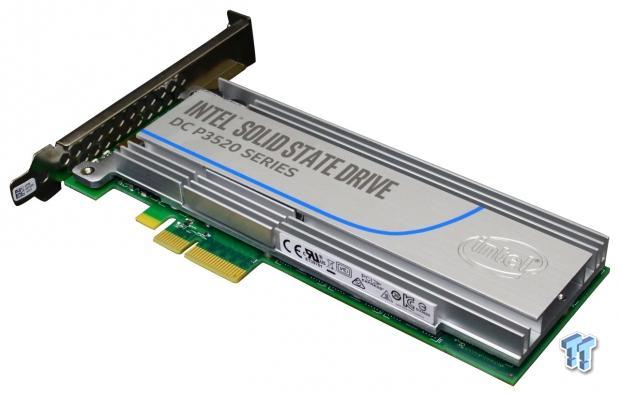
Intel's 3D flash-powered DC P3520 makes NVMe goodness much more affordable in the enterprise space. At 50 cents per gigabyte, the DC P3520 has a lot to offer. The read-centric DC P3520 fills the need for a mainstream performing enterprise SSD that has more to offer than SATA can deliver. One of the biggest assets the DC P3520 has going for it is a significantly lower power envelope than we've become accustomed to seeing from non-M.2 NVMe enterprise SSDs. Lower power consumption means that TCO is greatly reduced and ultimately a low TCO is the overriding goal of any datacenter operation.
Throughout our testing, we took notice of the DC P3520's exceptional performance at QD1. More often than not, the DC P3520 outperformed the DC P3700 at QD1 or QD1-4. The importance of low queue performance in the enterprise space is becoming more apparent as time goes on. Purveyors of enterprise SSDs generally like to trumpet the performance of their products at unrealistic queue depths of 64 and beyond. The fact is, 99% of the time the vast majority of datacenter workloads don't exceed QD32. In fact, the only reason we test up to QD256 is to verify that the test subject is capable of delivering advertised performance.
Intel's DC P3520 fills the need for a mainstream read-centric device in the datacenter by delivering what you need and nothing more. This keeps the initial cost and operational costs over the life of the drive to a minimum. Additionally, the goodness of NVMe means that QoS (Quality of Service) is much better than what SATA has to offer.
We feel that the DC P3520 delivers exactly what Intel intended and that it is worthy of a TweakTown Editor's Choice Award.
Pros:
- Available as HHHL AIC and U.2 versions
- Low Cost
- Read Performance
- Performance at QD1
Cons:
- 2TB Capacity Limit

| Performance | 90% |
| Performance Consistency | 98% |
| General Features | 98% |
| Value for Money | 99% |
| Quality, Design, Build and Warranty | 98% |
| Overall | 97% |
The Bottom Line: We believe that Intel's DC P3520 fills the need for a low-cost mainstream performing NVMe datacenter SSD better than anything we've seen to date.
PRICING: You can find products similar to this one for sale below.
 United
States: Find other tech and computer products like this
over at Amazon.com
United
States: Find other tech and computer products like this
over at Amazon.com
 United
Kingdom: Find other tech and computer products like this
over at Amazon.co.uk
United
Kingdom: Find other tech and computer products like this
over at Amazon.co.uk
 Australia:
Find other tech and computer products like this over at Amazon.com.au
Australia:
Find other tech and computer products like this over at Amazon.com.au
 Canada:
Find other tech and computer products like this over at Amazon.ca
Canada:
Find other tech and computer products like this over at Amazon.ca
 Deutschland:
Finde andere Technik- und Computerprodukte wie dieses auf Amazon.de
Deutschland:
Finde andere Technik- und Computerprodukte wie dieses auf Amazon.de
What's in Jon's PC?
- CPU: AMD Ryzen 7800X 3D
- MOTHERBOARD: GIGABYTE AORUS Master X670E
- RAM: Kingston Fury Renegade 7200MHz 32GB
- GPU: ZOTAC AMP Extreme GeForce RTX 4090
- SSD: Crucial T700 2TB Gen5
- OS: Windows 11 Pro
- COOLER: Lian Li Galahad 360 AIO
- CASE: Lian Li Lancool III
- KEYBOARD: Corsair K65 RGB Mini
- MOUSE: SteelSeries AEROX 5 Wireless
- MONITOR: ASUS ROG Strix PG27AQN 360Hz 1440p ULMB2
Similar Content
Related Tags

